生物专业英语
- 格式:pdf
- 大小:955.71 KB
- 文档页数:77
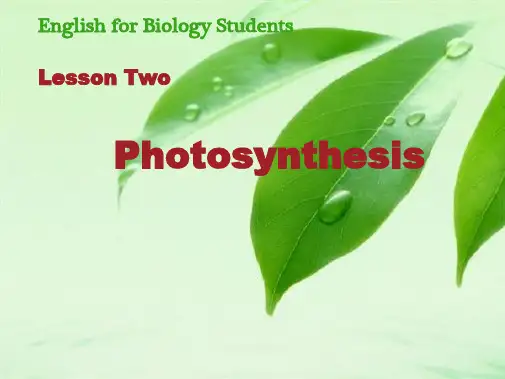
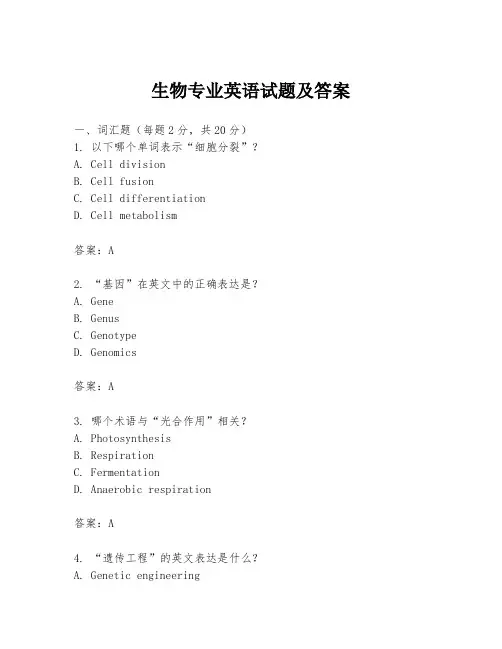
生物专业英语试题及答案一、词汇题(每题2分,共20分)1. 以下哪个单词表示“细胞分裂”?A. Cell divisionB. Cell fusionC. Cell differentiationD. Cell metabolism答案:A2. “基因”在英文中的正确表达是?A. GeneB. GenusC. GenotypeD. Genomics答案:A3. 哪个术语与“光合作用”相关?A. PhotosynthesisB. RespirationC. FermentationD. Anaerobic respiration答案:A4. “遗传工程”的英文表达是什么?A. Genetic engineeringB. Genetic mutationC. Genetic selectionD. Genetic variation答案:A5. “酶”的英文单词是?A. EnzymeB. HormoneC. ProteinD. Lipid答案:A6. “生态系统”在英文中如何表达?A. EcosystemB. BiosystemC. EcosystemsD. Biosphere答案:A7. “进化”的英文对应词是?A. EvolutionB. DevolutionC. InvolutionD. Revolution答案:A8. “克隆”在生物学中的英文术语是什么?A. CloningB. CopyingC. DuplicationD. Replication答案:A9. “物种”的英文单词是?A. SpeciesB. GenusC. VarietyD. Type答案:A10. “微生物”的英文表达是?A. MicroorganismB. MacroorganismC. OrganismD. Microbe答案:A二、阅读理解题(每题5分,共30分)阅读以下段落,并回答问题。
Biotechnology is the use of living organisms and bioprocesses to develop or make products. It involves the use of organisms, cells, and cellular components to research and produce goods and services. Modern biotechnology provides breakthrough products and technologies to combat debilitating and rarediseases, reduce our environmental footprint, feed the hungry, use less and cleaner energy, and have safer, cleaner and more efficient industrial manufacturing processes.11. 根据段落,生物技术涉及哪些方面?A. 使用生物和生物过程开发产品B. 仅使用生物过程C. 仅使用生物D. 使用生物和非生物过程答案:A12. 现代生物技术提供了哪些突破性的产品和技术?A. 治疗罕见疾病B. 减少环境影响C. 提供食物D. 所有上述选项答案:D13. 根据段落,生物技术如何帮助环境?A. 减少环境足迹B. 增加污染C. 加剧气候变化D. 消耗更多资源答案:A14. 生物技术如何帮助解决饥饿问题?A. 提供更少的食物B. 提供更多的食物C. 提高食物价格D. 降低食物质量答案:B15. 生物技术在工业制造中的作用是什么?A. 提高效率B. 降低安全性C. 增加污染D. 减少清洁度答案:A三、完形填空题(每题3分,共15分)阅读以下短文,从所给选项中选择最合适的一项填入空白处。
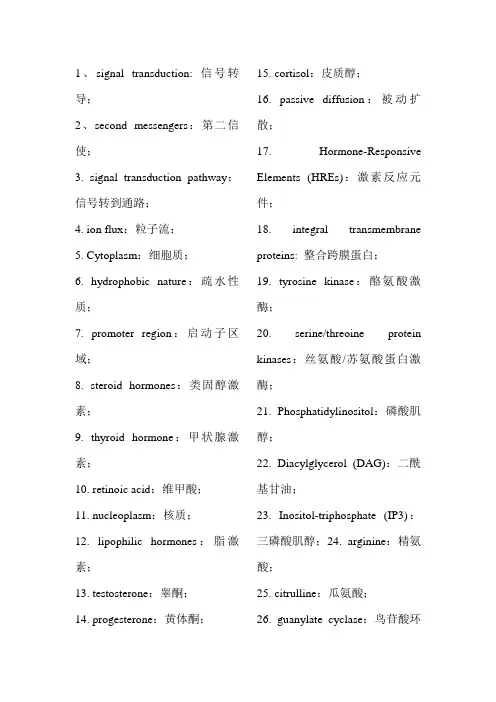
1、signal transduction: 信号转导;2、second messengers:第二信使;3. signal transduction pathway:信号转到通路;4. ion flux:粒子流;5. Cytoplasm:细胞质;6. hydrophobic nature:疏水性质;7. promoter region:启动子区域;8. steroid hormones:类固醇激素;9. thyroid hormone:甲状腺激素;10. retinoic acid:维甲酸;11. nucleoplasm:核质;12. lipophilic hormones:脂激素;13. testosterone:睾酮;14. progesterone:黄体酮;15. cortisol:皮质醇;16. passive diffusion:被动扩散;17. Hormone-Responsive Elements (HREs):激素反应元件;18. integral transmembrane proteins: 整合跨膜蛋白;19. tyrosine kinase:酪氨酸激酶;20. serine/threoine protein kinases:丝氨酸/苏氨酸蛋白激酶;21. Phosphatidylinositol:磷酸肌醇;22. Diacylglycerol (DAG):二酰基甘油;23. Inositol-triphosphate (IP3):三磷酸肌醇;24. arginine:精氨酸;25. citrulline:瓜氨酸;26. guanylate cyclase:鸟苷酸环化酶。
1.Cell communication : 细胞通讯;2. signal -transduction pathway:信号转导途径;3. growth factors:生长因子;4. paracrine signaling:旁分泌信号;5. neurotransmitter:神经递质;6. G-Protein-Linked Receptors: G-蛋白偶联受体;7. Tyrosine-Kinase Receptors:酪氨酸激酶受体;8. Ion-Channel Receptors:离子通道受体;9. Ligand-gated ion channels:配体门控离子通道;10. cytoskeleton:细胞骨架。
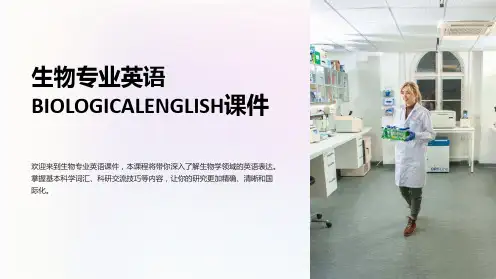

生物专业英语Biochemistry 生物化学essential element必需元素trace elements微量元素proteoglycan蛋白聚糖amino acid氨基酸primary structure 一级结构random coil无规卷曲structural domain 结构域subunit亚基degeneration变性adenine腺嘌呤guanine鸟嘌呤cytosine胞嘧啶thymine胸腺嘧啶uracil尿嘧啶nucleoside 核苷nucleotide核苷酸base pairing碱基配对base pair碱基对数base碱基数gyrase旋转酶nucleosome核小体 complementary DNA互补DNA plasmid质粒transposons转座子repetitive sequence重复序列exon外显子intron内含子variable loop可变环ribonuclease核糖核酸酶renaturation复性hyperchromic effect增色效应base stacking force碱基堆积力annealing退火melting-out temperature熔解温度hypochromic effect减色效应maltose麦芽糖sucrose蔗糖lactose乳糖starch淀粉glycogen糖原cellulose纤维素cellulase纤维素酶selectivity选择性substrate底物 holoenzyme全酶cofactor辅因子coenzyme辅酶oxidase氧化酶metabolism新陈代谢assimilation同化作用catabolism异化作用metabolite代谢产物biological oxidation 生物氧化cytochrome细胞色素rotenone鱼藤酮amytal阿密妥antimycin A抗霉素A cyanide氰化物glycolysis糖酵解ethanol乙醇citrate柠檬酸cis-aconitate 顺乌头酸succinic acid琥珀酸oxaloacetic acid草酰乙酸 acetyl-coenzyme乙酰辅酶fumarate延胡索酸glyoxylate cycle 乙醛酸循环malate苹果酸fatty acid 脂肪酸carbon unit一碳单位metabolic regulation代谢调feedback regulation反馈调节structural gene结构基因promoter gene启动基因operator gene操纵基因regulator gene调节基因termination factor终止因子triplet code三联体密码initiator codon起始密码termination codon终止密码replicon复制子core enzyme 核心酶primosome 引发体Okazaki fragment冈崎片段leading chain 前导链lagging strand后随链terminator终止子telomere端粒telomerase端粒酶replication fork复制叉vector载体promoter启动子terminator终止子operon操纵子codon密码子degeneracy简并性hormone激素citric acid cycle 柠檬酸循环Deamination 脱氨基作用urea cycle尿素循环euchromatin 常染色质messenger RNA信使RNAtransfer RNA 转移RNA ribosome RNA核糖体RNA secondary structure二级结构super-secondary structure超二级结构tertiary structure三级结构quaternary structure四级结构semiconservative replication 半保留复制ornithine cycle 鸟氨酸循环negative supercoil DNA负超螺旋DNA positive supercoil DNA正超螺旋DNA restriction endonuclease 限制性内切酶polymerase chain reaction 聚合酶链反应oxidative deamination 氧化脱氨作用transamination 转氨基作用reverse transcription 逆转录decarboxylation 脱羧作用semidiscontinuous replication半不连续复制reverse transcriptase 逆转录酶missense mutation 错义突变synonymous mutation 同义突变neutral mutation中性突变nonsense mutation 无义突变double-strand circular DNA 双链环形DNA phosphatidic acid 磷脂酸essential amino acids 必需氨基酸dihydrouracil loop 二氢尿嘧啶环anticodon loop 反密码子环superhelical DNA 超螺旋DNAopen circular DNA 开环DNA linear DNA 线形DNAbase stacking force 碱基堆积力glucogenic and ketogenic amino acid生糖兼生酮氨基酸ketogenic amino acid 生酮氨基酸glucogenic amino acid 生糖氨基酸Genetics遗传学heredity 遗传variation 变异pisum sativum 豌豆 segregation 分离gamete 生殖细胞zygote 合子allele 等位基因genotype 基因型phenotype 表现型test cross 测交oryza sativa 水稻diploid 二倍体haploid 单倍体centromere 着丝粒satellite 随体linker 连丝mitosis 有丝分裂mesoblast中胚层spindle 纺锤体interphase 间期spindle fiber 纺锤丝vicia faba 蚕豆nucleoplasm 核质spermatogenous 精原细胞oogonium 卵原细胞spermatid 精细胞Phenocopy 拟表型epistasis上位效应mutant突变型gametic lethal配子致死zygotic lethal合子致死autosome 常染色体dominant lethal显性致死carrier 携带者homozygote 纯合体heterozygote 杂合体genotype 基因型phenotype 表现型linkage group 连锁群interference 干涉coincidence 并发率genetic map 遗传学图wild type野生型secondary constriction 次级缢痕mutation 突变nucleolar organizer 核仁形成区induction 诱导first polar body 第一极体strain 菌株sister chromatids 姐妹染色单体recipient 受体female gametic nucleus 卵核donor 供体multiple alleles 复等位基因fragment 片段sex-chromosome性染色体heterokaryon 异核体sex-linked inheritance 伴性遗传auxotroph 营养缺陷型primary constriction 初级缢痕prophage 原噬菌体secondary constriction 次级缢痕transduction 转导complementary gene互补基因Mendel’s laws 孟德尔定律 law ofhomologous chromosome 同源染色体segregation 分离定律sister chromatids 姐妹染色单体first filial generation 子一代secondary oocyte 次级卵母细胞parental generation 亲代three-point testcross 三点测交dominant character显性性状primary spermatocyte 初级精母细胞recessive character 隐性性状secondary spermatocyte 次级精母细胞hereditary determinant遗传因子first division segregation 第一次分裂分离parental combination 亲组合second division segregation 第二次分裂分recombination 重组合离punnett square 棋盘法law of independent assortment 自由组合Mendelian character 孟德尔性状定律primary constriction 初级缢痕Microbiology微生物学living creatures 生物culture medium 培养基lawn菌苔culture plate 培养平板bacteria 细菌archaea 古生菌eukaryote真核生物prokaryote 原核生物protozoan 原生动物hypha 菌丝 mycoplasma 支原体yeast 酵母菌plasmolysis 质壁分离Escherichia Coli大肠杆菌murein胞壁质peptidoglycan 肽聚糖 mucopeptide 黏肽outer membrane外膜chromosome染色体nucleolus 核仁nucleoid 拟核chromatin 染色质 centromere 着丝粒telomere 端粒protoplast 原生质体mycoplasma 支原体glycoprotein 糖蛋白mesosome 间体 cytoplasm细胞质megnetosome磁小体nucleoid拟核glycocalyx 糖被capsule 荚膜flagellum 鞭毛lysosome 溶酶体chloroplast 叶绿体thylakoid类囊体inorganic salt 无机盐peptone 蛋白胨sulfur bacteria 硫细菌beef extract牛肉膏vitamin 维生素inclusion body 内含物lithotroph 无机营养型medium 培养基agar 琼脂organotroph 有机营养型antiport 逆向运输active transport 主动运输 pinocytosis 胞饮作用catabolism 分解代谢passive transport 被动运输 uniport 单向运输anabolism 合成代谢fermentation发酵batch culture 分批培养log phase 对数生长期stationary phase 稳定生长期lag phase 迟缓期decline phase衰亡期aerobe 好氧菌 antibiotic 抗生素antigenome 反基因组transformation 转化 genome 基因组plasmid 质粒transforming factor 转化因子diploid 二倍体haploid 单倍体transposable element 转座因子conjugation接合作用transposon转座子phenotype 表型genotype基因型auxotroph营养缺陷型wild-type野生型transition 转换transversion 颠换spontaneous mutation 自发突变reverse mutation 回复突变sexduction 性导transduction 转导 promoter 启动子operon 操纵子recombination repair 重组修复repressor 阻遏蛋白corepressor辅阻遏物clone 克隆 denaturation 变性annealing 退火extension 延伸cloning vector 克隆载体replicon 复制子telomere 端粒cohesive end 黏性末端promoter 启动子terminator 终止子gene therapy 基因治疗phylogeny 系统发育ammonification 氨化作用nitrification 硝化作用denitrification 反硝化作用expression vector 表达载体aerobic respiration有氧呼吸anaerobic respiration无氧呼吸origin of replication 复制起始点incompatibility 不亲和性gene mutation 基因突变synonymous mutation 同义突变chromosomal aberration 染色体畸变missense mutation 错义突变frame-shift mutation 移码突变lactose operon 乳糖操纵子negative transcription control 负转录调控 tryptophan operon 色氨酸操纵子 cytoplasmic inheritance 细胞质遗传 genetic engineering 基因工程 recombinant DNA technology 重组DNA技术palindromic structure 回文结构spread plate method 涂布平板法pour plate method 倾注培养法streak plate method 平板划线法shake tube method 稀释摇管法continuous culture 连续培养精品文档It was not evident, for example, whether or not a particular kind of protein has a consistent sequence of amino acids that would be the same in one individual molecule as it would be in another of that same kind of protein.例如,一类特定的蛋白质是否具有一致的氨基酸序列还是不明白的,同类蛋白质的单独一个分子与另一个分子的氨基酸序列也许是相同。
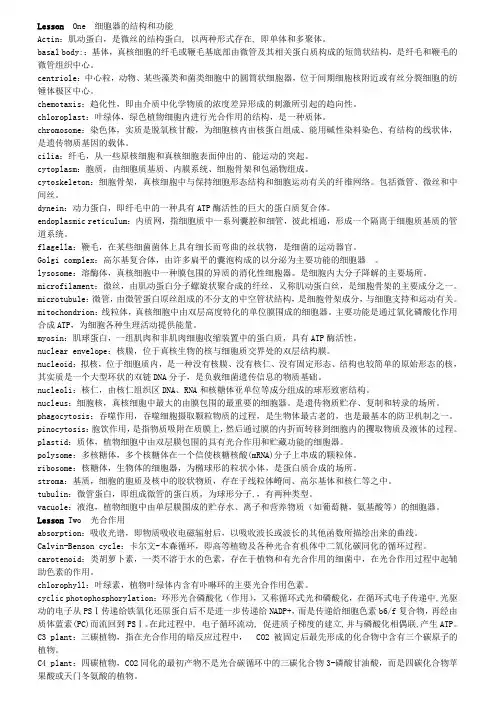
Lesson One 细胞器的结构和功能Actin:肌动蛋白,是微丝的结构蛋白, 以两种形式存在, 即单体和多聚体。
basal body::基体,真核细胞的纤毛或鞭毛基底部由微管及其相关蛋白质构成的短筒状结构,是纤毛和鞭毛的微管组织中心。
centriole:中心粒,动物、某些藻类和菌类细胞中的圆筒状细胞器,位于间期细胞核附近或有丝分裂细胞的纺锤体极区中心。
chemotaxis:趋化性,即由介质中化学物质的浓度差异形成的刺激所引起的趋向性。
chloroplast:叶绿体,绿色植物细胞内进行光合作用的结构,是一种质体。
chromosome:染色体,实质是脱氧核甘酸,为细胞核内由核蛋白组成、能用碱性染料染色、有结构的线状体,是遗传物质基因的载体。
cilia:纤毛,从一些原核细胞和真核细胞表面伸出的、能运动的突起。
cytoplasm:胞质,由细胞质基质、内膜系统、细胞骨架和包涵物组成。
cytoskeleton:细胞骨架,真核细胞中与保持细胞形态结构和细胞运动有关的纤维网络。
包括微管、微丝和中间丝。
dynein:动力蛋白,即纤毛中的一种具有ATP酶活性的巨大的蛋白质复合体。
endoplasmic reticulum:内质网,指细胞质中一系列囊腔和细管,彼此相通,形成一个隔离于细胞质基质的管道系统。
flagella:鞭毛,在某些细菌菌体上具有细长而弯曲的丝状物,是细菌的运动器官。
Golgi complex:高尔基复合体,由许多扁平的囊泡构成的以分泌为主要功能的细胞器。
lysosome:溶酶体,真核细胞中一种膜包围的异质的消化性细胞器。
是细胞内大分子降解的主要场所。
microfilament:微丝,由肌动蛋白分子螺旋状聚合成的纤丝,又称肌动蛋白丝,是细胞骨架的主要成分之一。
microtubule:微管,由微管蛋白原丝组成的不分支的中空管状结构,是细胞骨架成分,与细胞支持和运动有关。
mitochondrion:线粒体,真核细胞中由双层高度特化的单位膜围成的细胞器。
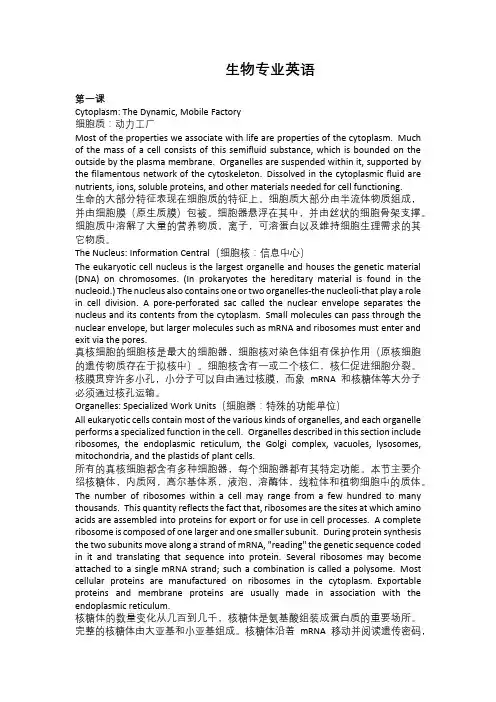
生物专业英语第一课Cytoplasm: The Dynamic, Mobile Factory细胞质:动力工厂Most of the properties we associate with life are properties of the cytoplasm. Much of the mass of a cell consists of this semifluid substance, which is bounded on the outside by the plasma membrane. Organelles are suspended within it, supported by the filamentous network of the cytoskeleton. Dissolved in the cytoplasmic fluid are nutrients, ions, soluble proteins, and other materials needed for cell functioning.生命的大部分特征表现在细胞质的特征上。
细胞质大部分由半流体物质组成,并由细胞膜(原生质膜)包被。
细胞器悬浮在其中,并由丝状的细胞骨架支撑。
细胞质中溶解了大量的营养物质,离子,可溶蛋白以及维持细胞生理需求的其它物质。
The Nucleus: Information Central(细胞核:信息中心)The eukaryotic cell nucleus is the largest organelle and houses the genetic material (DNA) on chromosomes. (In prokaryotes the hereditary material is found in the nucleoid.) The nucleus also contains one or two organelles-the nucleoli-that play a role in cell division. A pore-perforated sac called the nuclear envelope separates the nucleus and its contents from the cytoplasm. Small molecules can pass through the nuclear envelope, but larger molecules such as mRNA and ribosomes must enter and exit via the pores.真核细胞的细胞核是最大的细胞器,细胞核对染色体组有保护作用(原核细胞的遗传物质存在于拟核中)。
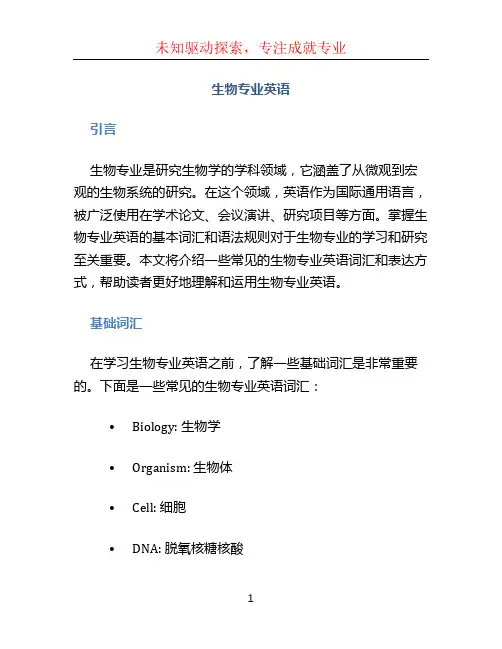
生物专业英语引言生物专业是研究生物学的学科领域,它涵盖了从微观到宏观的生物系统的研究。
在这个领域,英语作为国际通用语言,被广泛使用在学术论文、会议演讲、研究项目等方面。
掌握生物专业英语的基本词汇和语法规则对于生物专业的学习和研究至关重要。
本文将介绍一些常见的生物专业英语词汇和表达方式,帮助读者更好地理解和运用生物专业英语。
基础词汇在学习生物专业英语之前,了解一些基础词汇是非常重要的。
下面是一些常见的生物专业英语词汇:•Biology: 生物学•Organism: 生物体•Cell: 细胞•DNA: 脱氧核糖核酸•RNA: 核糖核酸•Protein: 蛋白质•Enzyme: 酶•Gene: 基因•Mutation: 突变•Evolution: 进化•Ecology: 生态学•Species: 物种•Habitat: 栖息地•Photosynthesis: 光合作用•Reproduction: 繁殖•Metabolism: 新陈代谢•Microorganism: 微生物•Biotechnology: 生物技术•Genetic engineering: 基因工程学术论文写作在生物专业中,学术论文写作是非常重要的一部分。
下面是一些常用的生物专业论文写作的词汇和表达方式:1.引言部分(Introduction)•In recent years, there has been growing interest in…(近年来,对…的兴趣越来越浓)•The purpose of this study is to…(本研究的目的是…)•This paper aims to investigate…(本文旨在调查…)2.方法部分(Methods)•The experimental proce dure was as follows…(实验步骤如下…)•The samples were collected from…(样本来源于…)•Statistical analysis was performed using…(使用…进行统计分析)3.结果部分(Results)•The results showed that…(结果表明…)•The data presented in Figure 1 indicate that…(图1所示数据表明…)•There was a significant diffe rence between…(…之间存在显著差异)4.讨论部分(Discussion)•The findings of this study are in line with previous research…(本研究的发现与先前的研究一致)•The results suggest that…(结果表明…)•The limitations of this study should be acknowledged…(应该承认本研究的局限性)5.结论部分(Conclusion)•In conclusion, this study provides evidence that…(总之,本研究提供了…的证据)•Further research is needed to…(需要进一步的研究来…)•This study contributes to our understanding of…(本研究有助于我们对…的理解)会议演讲在生物专业领域,会议演讲是学术交流的重要一环。
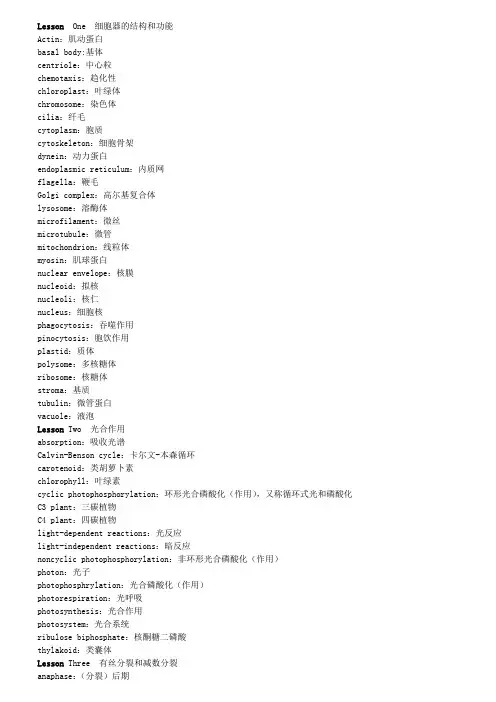
Lesson One 细胞器的结构和功能Actin:肌动蛋白basal body:基体centriole:中心粒chemotaxis:趋化性chloroplast:叶绿体chromosome:染色体cilia:纤毛cytoplasm:胞质cytoskeleton:细胞骨架dynein:动力蛋白endoplasmic reticulum:内质网flagella:鞭毛Golgi complex:高尔基复合体lysosome:溶酶体microfilament:微丝microtubule:微管mitochondrion:线粒体myosin:肌球蛋白nuclear envelope:核膜nucleoid:拟核nucleoli:核仁nucleus:细胞核phagocytosis:吞噬作用pinocytosis:胞饮作用plastid:质体polysome:多核糖体ribosome:核糖体stroma:基质tubulin:微管蛋白vacuole:液泡Lesson Two 光合作用absorption:吸收光谱Calvin-Benson cycle:卡尔文-本森循环carotenoid:类胡萝卜素chlorophyll:叶绿素cyclic photophosphorylation:环形光合磷酸化(作用),又称循环式光和磷酸化C3 plant:三碳植物C4 plant:四碳植物light-dependent reactions:光反应light-independent reactions:暗反应noncyclic photophosphorylation:非环形光合磷酸化(作用)photon:光子photophosphrylation:光合磷酸化(作用)photorespiration:光呼吸photosynthesis:光合作用photosystem:光合系统ribulose biphosphate:核酮糖二磷酸thylakoid:类囊体Lesson Three 有丝分裂和减数分裂anaphase:(分裂)后期cell plate:细胞板centromere:着丝粒chalone:抑素,chromatid:染色单体chromatin:染色质cytokinesis:胞质分裂diploid:二倍体haploid:单倍体★histone:组蛋白homologous pair:同源染色体对interphase(cycle):分裂间期(周期)karyotype:核型★meiosis:减数分裂★mitosis:有丝分裂metaphase:(分裂)中期metaphase plate:赤道板nucleosome:核小体prophase:(分裂)前期spindle:纺锤体telophase:(分裂)末期Lesson Four 遗传学基本原理allele:等位基因dominant:显性★recessive:隐性的dihybrid cross:双因子杂合子杂交gene:基因genotype:基因型phenotype:表现型germ plasm theory:种质学说heterozygous:杂合的homozygous:纯合的incomplete dominance:不完全显性law of independent assortment:独立分配定律law of segregation:分离定律nondisjunction:不分离★pangenesis:泛生论Punnett square:庞纳特方格test cross:测交Lesson Five 基因的化学性质purine:嘌呤pyrimidine:嘧啶adenine:腺嘌呤guanine:鸟嘌呤cytosine:胞嘧啶thymine:胸腺嘧啶★DNA polymerase:DNA聚合酶★double helix:双螺旋nucleoside:核苷Okazaki fragment:冈崎片段one-gene-one-enzyme hypothesis:一基因一酶假说one-gene-one-polypeptide hypothesis:一基因一多肽假说replication fork:复制叉semiconservative replication:半保留复制X-ray diffraction:X射线衍射Lesson Six 生命的起源和多样性Big Bang:大爆炸binomial system of nomenclature:双名法clade:进化枝taxon:分类群taxonomy:分类学coacervate:团聚体continental drift:大陆漂移core:核心mantle:地幔crust:地壳ozone layer:臭氧层kingdom:界division:门class:纲order:目family:科genus:属species:种liposome:脂质体proteinoid:类蛋白(质)Lesson Seven 最大的分解者—真菌ascus:子囊ascomycetes:子囊菌conidium:分生孢子子实体basidium:担子basidiocarp:担子果basidiomycetes:担子果菌纲Fungi Imperfecti(Decteromycetes):半知菌门sporangium:孢子囊gametangium:配子囊haustorium:吸器heterokaryon:异核体hyphae:菌丝lichen:地衣mycelium:菌丝体rhizoid:假根saprobe:腐生菌septate:有隔膜的Lesson Eight 动物发育acrosome reaction:顶体反应fertilization:受精cleavage:卵裂blastomere:(卵)裂球blastula:囊胚gastrula:原肠胚primitive streak:原条gastrulation:原肠胚形成ectoderm:外胚层endoderm:内胚层mesoderm:中胚层compensatory hypertrophy:代偿性肥大dedifferentiation:脱分化differentiation:分化gene amplification:基因扩增metamorphosis:变态morphogenesis:形态发生neurulation:神经胚形成oogenesis:卵(子)发生organogenesis:器官发生ovaries:卵巢oviduct:输卵管ovum:卵yolk:卵黄sperm:精子spermatogenesis:精子发生zygote:受精卵parthenogenesis:孤雌生殖regeneration:再生Lesson Nine 物种的起源allopatric speciation:异域物种形成sympatric speciation:同域物种形成analogy:同功cline:梯度变异convergent evolution:趋同进化divergent evolution:趋异进化extinction:灭绝homology:同源性hybrid sterility:杂种不育性macroevolution:宏观进化microevolution:微进化parallel evolution:平行进化phylogeny:种系发生punctuated equilibrium:间断平衡,Lesson Ten 种群生态学age structure:年龄结构allelopathy:异种相克相成现象carrying capacity:容纳量character displacement:特征替换density-dependent factors:密度制约因子density-independent factors:非密度制约因子exponential growth curve:指数生长曲线logistic growth curve:逻辑生长曲线interspecific competition:种间竞争intraspecific competition:种内竞争mortality:死亡率natality:出生率population density:种群密度survivorship curve:存活曲线。
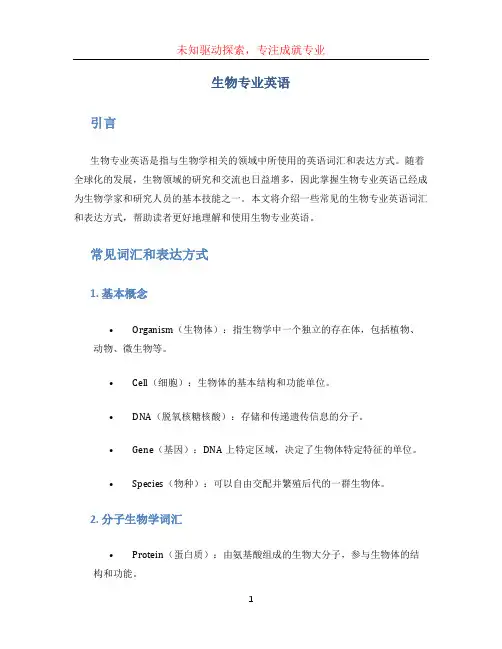
生物专业英语引言生物专业英语是指与生物学相关的领域中所使用的英语词汇和表达方式。
随着全球化的发展,生物领域的研究和交流也日益增多,因此掌握生物专业英语已经成为生物学家和研究人员的基本技能之一。
本文将介绍一些常见的生物专业英语词汇和表达方式,帮助读者更好地理解和使用生物专业英语。
常见词汇和表达方式1. 基本概念•Organism(生物体):指生物学中一个独立的存在体,包括植物、动物、微生物等。
•Cell(细胞):生物体的基本结构和功能单位。
•DNA(脱氧核糖核酸):存储和传递遗传信息的分子。
•Gene(基因):DNA上特定区域,决定了生物体特定特征的单位。
•Species(物种):可以自由交配并繁殖后代的一群生物体。
2. 分子生物学词汇•Protein(蛋白质):由氨基酸组成的生物大分子,参与生物体的结构和功能。
•Enzyme(酶):催化生物体内化学反应的蛋白质。
•Expression(表达):基因在蛋白质水平上的转录和翻译过程。
•Mutation(突变):基因序列的突发性改变,可能导致生物体表现出不同的特征。
•Polymerase Chain Reaction(聚合酶链反应):一种用于扩增DNA 分子的技术。
3. 遗传学词汇•Heredity(遗传):生物特征通过基因传递给后代的过程。
•Allele(等位基因):基因的不同变体。
•Genotype(基因型):生物体内基因的组合。
•Phenotype(表型):基因型在外部可观察到的表现。
•Genetic Variation(遗传变异):生物体内基因和等位基因的变异。
4. 生态学词汇•Ecosystem(生态系统):由生物体和环境相互作用组成的一个自然单位。
•Biodiversity(生物多样性):生物体种类和数量的多样性。
•Food Chain(食物链):生物体之间通过食物相互联系的关系网。
•Conservation(保护):保护自然资源和环境,维护生物多样性的活动。
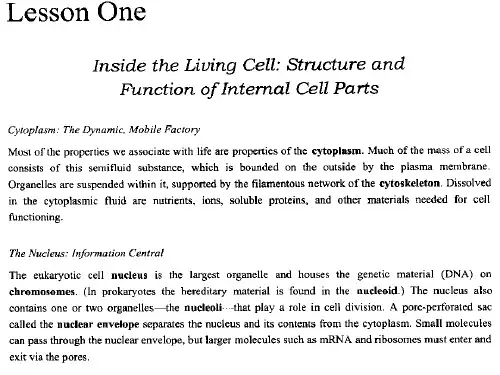
生物专业英语试题及答案一、选择题(每题2分,共20分)1. Which of the following is not a type of cell organelle?A. MitochondriaB. NucleusC. RibosomeD. Cell wall2. The process of DNA replication is catalyzed by:A. PolymeraseB. TransposaseC. LigaseD. Helicase3. In eukaryotic cells, where is the transcription of DNA primarily carried out?A. CytoplasmB. MitochondriaC. NucleusD. Ribosomes4. What is the basic unit of heredity in all living organisms?A. GeneB. ChromosomeC. DNA moleculeD. Protein5. The term "genome" refers to:A. The complete set of genes of an organismB. The entire DNA of an organismC. The sum of all the proteins in an organismD. The collection of all the cells in an organism6. Which of the following is a method of genetic engineering?A. CrossbreedingB. CloningC. CRISPR-Cas9D. Natural selection7. What is the role of tRNA in protein synthesis?A. To provide the energy for the processB. To carry specific amino acids to the ribosomeC. To serve as the template for protein synthesisD. To catalyze the formation of peptide bonds8. The Hardy-Weinberg principle states that the allele frequencies in a population will remain constant in the absence of:A. MigrationB. Genetic driftC. Natural selectionD. All of the above9. Which of the following is not a type of mutation?A. DeletionB. InsertionC. TranslocationD. Translation10. The process of photosynthesis primarily occurs in the:A. Cell wallB. CytoplasmC. ChloroplastsD. Nucleus二、填空题(每空1分,共10分)1. The chemical structure of DNA is a double ________ helix.2. The process by which a fertilized egg develops into a mature organism is called ________.3. In genetics, the term "dominant" refers to an allele that expresses its effect when ________.4. The scientific name for a species is composed of two parts: the genus name and the ________ name.5. The primary function of the Golgi apparatus is to ________, modify, and package proteins for secretion or delivery toother organelles.三、简答题(每题10分,共20分)1. Explain the difference between prokaryotic and eukaryotic cells.2. Describe the process of mitosis and its significance incell division.四、翻译题(每题15分,共30分)1. Translate the following sentence into English:"基因编辑技术,如CRISPR-Cas9,为研究和治疗遗传性疾病提供了新的可能性。
生词•fertilize [‘fз:tilaiz]vt.使肥沃;使受孕;施肥•clear-cut adj. 轮廓鲜明的;清晰的••progeny ['prכּdзəni:] •n. 子孙;后裔;结果;结局•ratio ['rei∫iəu] n. 比,比率;比例;系数•filial ['fili:əl] adj. 子女的adv. 子女地•offspring [´כּf.spriŋ] n. 后代,ε子孙;•deduced [di'dju:st] v. 推论,演绎•hereditary [hi'reditəri] adj. 遗传的;世袭的;遗传性•hypothesized [hai'pכּθisaizd]•v. 假设,假定,猜测ratio ['rei∫iəu] n. 比,比率;比例;系数•pictorial [pik'tכּ:ri:əl] adj.绘画的;有图片的;图画似的;形象化的•n. 画报;画刊;画页;图画邮票representatio[.reprizen'tei∫ən] •n. 表现;陈述;表现……的事物;有代理人•gamete[英] ['ɡæmi:t] •n. 接合体,配偶子•mating ['meitiŋ] •n. (鸟兽等的)交配,交尾,(植物等的)杂交;配种;配套•intermediate [英][.intə'mi:djət]•adj. 中间的,中级的•n. 中间物,中间分子,中间人••exert [英] [iɡ'zə:t] vt. 发挥;运用;使受(影响等);用(力)•sex-linked[英] ['seksliŋkt] •adj. 伴性的。
《生物专业英语》专业词汇1.electron microscopy 电子显微镜2.chloroplast 叶绿体3.mitochondria 线粒体4.phospholipid 磷脂5.lipid bilayer 脂双层6.plasma membrane 质膜7.extracellular 细胞外的8.cellulose纤维素9.polysaccharides多糖10.vacuole液泡11.chromatin 染色质12.eukaryotic 真核的13.prokaryotic 原核的14.ribosomes核糖体15.thylakoids类囊体16.peroxisomes, 过氧物酶体17.hydrolytic enzyme 水解酶18.cytoskeleton 细胞骨架19.Chlorophyll 叶绿素20.Chromosome 染色体21.Glycolysis醣酵解22.Microtubule微管anelle细胞器24.Prokaryotic cell 原核细胞25.apoptosis细胞凋亡26.endocytosis 细胞内吞作用27.graminaceous plant禾本科植物28.Pharmacology 药理学29.morphology形态学30.anatomy解剖学31.taxonomy 分类学32.binary nomenclature 双名法33.ontogenesis个体发生34.phylogenesis系统发生35.nanometer 纳米36.micrometer 微米limeter 毫米38.centimeter 厘米39.decimeter分米40.flora植物志,植物群落41.homologous同源的42.plasmodesmata [植]胞间连丝43.plasmolysis质壁分离44.tonoplast液泡膜45.hydrodynamics流体力学, 水动力学46.leucoplast 白色体47.Proplastid 前质体, 原质体48.carotinoid 类胡萝卜素49.saprophytic腐生的50.parasitic寄生的51.endosperm 胚乳52.concentric同中心的53.eccentric偏心的,偏轴的,离心的54.vascular tissue维管组织55.lignin 木质素,56.Chromoplast 有色体57.Amyloplast 淀粉体58.Epidermis 表皮59.Saprophy 腐生60.histology 组织学61.cytology 细胞学62.bacteriology细菌学63.prototype原型64.tobacco mosaic virus (TMV)烟草花叶病毒65.The Transmission Electron Microscope (TEM)透射电子显微镜66.The scanning electron microscope (SEM)扫描电子显微镜67.solid phase 固相68.gas phase 气相69.liquid phase 液相70.ultraviolet light紫外光71.wave length 波长72.subcellular structure 亚细胞结构73.endoplasmic reticulum 内质网74.lipophilic亲脂性的75.assimilation tissue同化组织76.xylem木质部77.phloem韧皮部78.Meristem 分生组织79.embryogenesis胚胎发生80.symmetric对称的81.inflorescence 花, 花序82.apical meristem 顶端分生组织teral meristem侧生分生组织84.intercalary meristem居间分生组织85.apical dominance[植]顶端优势86.gymnosperm 裸子植物87.angiosperm被子植物88.vascular cambium维管形成层89.cork cambium木栓形成层90.annual rings年轮91.internode节间92.morphogenesis形态发生,形态建成,93.differentiate 分化94.dedifferentiate 去分化,反分化95.totipotency 全能, 全能性96.root cap根冠.97.leaf vein叶脉98.radical apex 根尖99.Procambium原始形成层100.cross-section横截面101.parenchyma 薄壁组织102.ornamental plant观赏植物103.Isodiametric等直径的, 等轴的104.lignify木质化105.parasite寄生虫106.xerophyte旱生植物107.Aquatic plant水生植物108.shade plant阴生植物109.guard cell 保卫细胞110.intercellular space细胞间隙111.photosynthesis 光合作用112.anaerobic厌氧的113.infrared light 红外光114.redox氧化还原作用115.cofactor辅助因素116.photosystem 光系统117.cytochrome细胞色素118.ATP (adenosine triphosphate) 三磷酸腺苷119.carboxylase羧化酶120.oxygenase 加氧酶121.photorespiration 光呼吸122.Carbohydrate 糖;碳水化合物123.Mesophyll 叶肉124.Photoinhibition n. 光抑制125.Plastoquinone 质体醌126.antioxidant 抗氧化剂127.decarboxylation脱羧128.autotrophic organisms自养生物129.thermodynamic热力学的130.biodiversity 生物多样性131.symbiotic relationship共生关系132.endosymbiosis内共生133.hydrophobic疏水的134.hydrophilic亲水的135.nanotechnology纳米技术136.biomedical生物医学的137.fluorescent荧光的, 莹光的138.pharmaceutical医药品139.nutraceutical营养品140.promoter启动子141.bioremediation生物补救,生物修复142.biological breakdown生物降解143.interdisciplinary学科间的144.entomology昆虫学145.weed science草业科学146.ecosystem生态系统147.Taxonomy分类学pound eyes复眼149.Fungi真菌150.invasivespecies入侵种151.ScienceCitation Index科学引文索引152.the National Institutes of Health(美国)全国卫生研究所153.Neuroscience.神经系统科学154.ISSN(international standard serial number)国际标准期刊编号155.Semimonthly半月的156.Bimonthly双月的157.Quarterly季度的,三月的158.Engineering Index (EI)工程(技术资料)索引159.dissertation(学位)论文160.Biophysics生物物理学161.Immunology免疫学162.Pathology病理学163.Physiology生理学164.Virology病毒学165.Systematic Biology系统生物学166.antibiotic抗生素167.Genomics基因组学168.pesticide杀虫剂ctic-acid乳酸170.recombinant重组体171.allergic过敏的,患过敏症的172.insulin胰岛素173.identical twins同卵双生174.Dolly the Sheep多利羊175.zygote合子,受精卵176.reproductive cell生殖细胞177.Somatic cell体细胞178.Somatic cell nuclear transfer (SCNT)体细胞核移植179.Artificial embryo twinning人工胚胎双生180.surrogate mother替身母亲181.trial-and-error反复试验182.Implantation移植,培植183.Telomeric端粒的184.telomere端粒185.lifespan寿命186.infertility不育187.in vitro体外,在生物体外188.in vivo在活的有机体内189.genotype基因型190.phenotype表现型,表型191.germination萌芽,发生192.Growth regulator生长调节剂193.auxin生长素194.cytokinin细胞分裂素195.metabolite代谢物196.micropropagation微繁197.disinfection消毒,灭菌198.autoclave高压灭菌器199.explant外植体200.Vector载体201.cancerous tissue癌组织的202.Vaccine疫苗203.Embryonic tissue胚性组织204.homogenize均质化205.bacteriophage噬菌体206.sticky end粘性末端207.blunt end平末端208.ligase连接酶209.codon密码子210.bovine牛的211.transgenic转基因的212.pathogen病菌,病原体213.glucose isomerase葡萄糖异构酶214.starch saccharification淀粉糖基化215.restriction endonuclease限制性内切核酸酶216.rate-determining step限速步骤217.enzymic catalysis酶学催化反应218.specificity特异性219.hydrogen bond氢键220.thermostability热稳定性221.Mutant突变异种,突变体222.Penicillin青霉素223.biosensor生物传感器224.optical isomers光学异构体225.hydrolysis水解226.hexokinase己糖激酶227.hexose己醣228.fructose果糖229.noncovalent非共价键的230.coenzyme辅酶231.Oxidoreductase氧化还原酶232.dehydrogenases脱氢酶233.oxidase氧化酶234.oxygenase加氧酶235.peroxidase过氧(化)物酶236.Transferase转移酶237.Hydrolase水解酶238.esterase酯酶239.glycosidase糖苷酶240.lipase脂肪酶241.protease蛋白酶242.dehydratase脱水酶243.pectinase果胶酶244.Isomerase异构酶245.isomerisation异构化246.epimerase差向(异构)酶247.synthetase合成酶248.pancreas胰腺249.intestine肠250.receptor受体251.Terminator终止子252.anticodon反密码子253.peptide bond肽键254.detoxification解毒,脱毒255.soybean大豆256.trans反式257.cis顺式258.cardiovascular disease心血管疾病259.homogeneous同类的,相似的,均一的260.heterogeneous不同种类的261.carcinogenic致癌物(质)的262.bioethics生物伦理学263.multidisciplinary多学科的264.pesticide杀虫剂265.bioreactor生物反应器266.the Royal Society(英国)皇家学会267.FAO=Food and Agriculture Organization (of the United Nations)(联合国)粮食及农业组织268.broad sense广义的269.narrow sense狭义的270.genetically modified organisms (GMOs)遗传修饰生物271.fishery渔业272.forestry林业273.Marker-assisted selection标记辅助选择274.DNA fingerprintingDNA指纹275.quantitative trait loci数量性状位点276.allergenic引起过敏的277.cultivar栽培品种278.Biosafety生物研究安全性279.Amino acid氨基酸280.Autofluorescence自发荧光281.Base pair碱基对282.Biodiversity生物多样性283.Carotinoid类胡萝卜素284.Centromere着丝点,着丝粒285.Cytoplasm细胞质286.Differentiation分化287.Embryo胚胎,胎儿,胚芽288.Entomology昆虫学289.Genome基因组/染色体组290.Glycosylate使糖基化291.Hybridization杂交,杂种培植,配种292.Inheritance遗传293.Kidney肾脏294.Lysosome溶酶体295.Mammalian哺乳动物296.Meiosis减数分裂297.Micronutrient微量元素298.Mitosis有丝分裂299.Monocotyledon单子叶植物300.dicotyledon双子叶植物301.Mutation突变302.Nucleotide核苷303.Phospholipid磷脂304.Polymerase聚合酶305.Polypeptide多肽306.polymorphism多态性,多型性1.界Kingdom2.门Phylum3.纲class4.目Order5.科family6.属genus7.种Species8.品种variety专业英语单词整理haplo,mono,uni:单,一,独 haploid 单倍体; monoxide 一氧化物bi,di,dipl,twi,du: 二,双,两,偶 dichromatic 双色的;diplobacillus 双杆菌tri: 三,丙 triangle 三角;triacylglycerol 三酰甘油quadri,quadru,quart,tetr,tetra:四 quadruped 四足动物;tetracycline 四环素pent,penta,quique: 五 pentose 戊糖;pentane 戊烷hex,hexa,sex: 六 hexose 已糖 hexapod 六足动物;hexamer 六聚体hepta,sept(i): 七 heptane 庚烷 heptose 庚糖 heptoglobin 七珠蛋白oct: 八octopus 章鱼 octagon 八角形 octane 辛烷 octase 辛糖ennea,nona: 九 nonapeptide 九肽 enneahedron 九面体deca,deka: 十decapod 十足目动物 decahedron 十面体 decagram 十克demi-,hemi-,semi-: 半hemicerebrum 大脑半球;semiopaque 半透明holo-: 全,整体,完全 holoenzyme 全酶;holocrine 全分泌mega-: 巨大,兆,百万 megaspore 大孢子;megakaryocyte 巨核细胞macro-: 大,巨大,多 macrophage 巨噬细胞;macromolecular 大分子的poly-,multi-,mult-: 多,复合 polyacrylate 聚丙烯酸酯;polymerase 聚合酶ab- 去,离开 abarticular 关节外的;abaxial 离轴的acro- 顶,向顶 acrosome 顶体;acrospire 顶芽,初生叶Ambi-, amb-, ambo- 两侧,二,复 ambiopia 复视;ambosexual 两性的amphi- 二,两,双 amphibia 两栖类;amphinucleoli 双核仁pan- 完全 panagglutination 全凝集;panarthritis 全关节炎-ase 酶 protease 蛋白酶;polymerase 聚合酶-ate 盐,酯 phosphate 磷酸盐;sebacate 奎二酸酯-gen 原,剂 antigen 抗原;mutagen 诱变剂-ose 糖 heptose 庚糖,lactose 乳糖-some 体,粒 chromosome 染色体;idiosome 核旁体-phil 亲,嗜,喜 acidophil 嗜酸的,aerophil 好气的-derm 皮,皮层;derma- blastoderm 胚层;dermadrone 内病性皮疹-lemma 皮,壳,鞘膜 basilemma 基底膜;lemmatoxin 鞘毒素-nema 丝,线 amphinema 偶线;chromonema 染色线;nemacicide 杀线虫剂-osic 病,症;-itis acalcicosis缺钙症;hepatitis 肝炎Bacteri(o): 细菌 bacteriocin 细菌素;bacteriophage 嗜菌体Biosis: 生命 anhydrobiosis 脱水生活;dysbiosis 生态失调Carbo: 碳carbocyclic 碳环的;carbonate 碳酸盐Carcin(o): 癌 carcinogen 致癌物;carcinocidin 消癌菌素Caryo: 核 eucaryotic 真核的,caryogenesis 核发生Chemo: 化学 chemotherapy 化学疗法; chemoautotrophy 化能自养(生物) Chlor(o): 绿,氯 chlorophilline 叶绿素;chlorophore 载绿体;chloride 氯化物Chondri(o): 软骨,颗,粒chondriglucose 软骨葡萄糖;chondriosome 线粒体Eryth(ro): 红 erythromycin 红霉素;erythrocyte 红血球Embryo: 胚胎embryogenesis 胚胎发生;embryoblast 成胚细胞Dys-: 不良,异常,障碍 dys-cyclia 循环障碍;dysembryoma 畸胎瘤Eu-: 常,真,好 eucaryote 真核生物;eubacteria 真细菌Exo-: 外 exon 外显子;exonuclease 核酸外切酶Idio-: 独有,特异 idiobiology 个体生物学;idioblast 异细胞Iso-: 等,同,异 isozyme 同功酶;isotropic 各向同性的;isopropanol 异丙醇Hetero-: 异,杂,不同 heterocyclic 杂环的; heterochromosome 异染色体Homeo-: 同祖,(部分)同源homeoallele 部分同源等位基因;homeotransplant 同种移植Homo-: 同,同源,高homocaryon 同核体;homocysteine 高半胱氨酸;homothermal 恒温的Hyalo-: 玻璃、透明hyaloplasm 透明质;hyalospore 无色孢子Cardia(o): 心amyocardia 心肌无力;angiocardiopathy 心血管病;bradycardia 心动过缓Cryo: 冷,冻 cryoadhesion 冷冻粘结;cryoalgae 冰雪藻类Feti(o): 胎feticide 堕胎;fetoscopy 胎镜Fibr(o): 纤维 fibroblast 成纤维细胞;fibrocarcinoma 纤维癌Flav:黄flavoprotein黄素蛋白;thioflavin硫磺素Lip(o)-:脂(的)lipophilic亲脂的;lipoadenoma脂肪腺瘤Lys(o)-:溶、解、分、离lysozyme溶菌酶;lysate溶解产物;lysophagosome吞噬溶酶体Leuc(o)-:无色、白、白细胞leucoagglutinin白细胞凝集素;leucogenenol促白细胞生成素Melan(o)-:黑melanophore载黑素细胞;melanocarcinoma黑素细胞癌Telo-:端,末尾telophase有丝分裂末期;telomerase端粒酶Morpho:形、形态amorphous无定形的;morphogenesis形态发生Myo:肌肉myoglobin肌球蛋白;myoadenofibroma肌腺纤维瘤Neuro:神经neuroangiomatosis神经血管瘤病;neuroepidermal神经表皮的Meso:中、介mesoderm中胚层;mesozoic中生代的Meta:异、变、偏、次、后、中、转metachrome异染色体;metamorphosis变形Organ(o):器官,有机organacidia有机酸症organelle细胞器Ion:离子anion阴离子;zwitterion两性离子Reticul(o):网reticulocyte网织红细胞;reticuloendothelial网状内皮的Vacuo:空,泡,管vacuoplast液泡体;vacuolus液泡Tox:毒toxin毒素;toxemia毒血症Fluor(o):氟,荧光fluorochrome荧光染料;fluorescence荧光Gam:性,婚配、gamete配子;gamic受精的Geno:遗传,基因,种族,生殖genotype基因型;genopathy遗传病Glyc(o),Gluc(o):甜、糖glycoside糖苷;glucohemia糖血症Gyno:雌性gynogamone雌配素;gynospore雌孢子H(a)emo:血haemoglobin血红蛋白;hemocyanin血蓝蛋白Helio:太阳、光heliophilous喜阳的;heliosis中暑Hist(o):组织histocompatibility组织相容性;histidine组氨酸;histone组蛋白Immuno:免疫immunoautoradiography免疫放射自显影Kine(to):动kinetin激动蛋白;kinetochore动粒,着丝点Onco肿瘤,癌oncogene,致癌基因;oncolysis溶癌作用;oncovirus致癌病毒O(v)o卵,蛋oocyte卵母细胞, oocyan卵清蛋白, ovogenesis卵子发生Patho病pathotoxins疾病毒素, pathobolism病理代谢Peri周,围pericardial,心周的;perikaryon核周体Phospho磷酸phosphodiester磷酸二酯Phyto植物phytokinase,植物激酶phytoferritin植物铁蛋白Proto原,初protofibril,原纤维protolignin原木质素Pseudo假,拟pseudoembryo,假胚胎pseudodominance拟显性Vertebrate脊椎动物Rodent啮齿动物Reptile爬行动物Amphibian两栖动物Protozoan原生动物Primate灵长类动物homo sapiens人类abdomen 腹部gall bladder胆囊pancreas胰腺spleen脾duodenum十二指肠small intestine小肠large intestine大肠 blind gut盲肠vermiform appendix阑尾 rectum直肠anus肛门hip臀部joint关节vein静脉capillary毛细血管windpipe气管gullet食管。
常用生物专业英语Glucose 葡萄糖Starch 淀粉Glycogen 糖原Cellulose 纤维素Amino Acid 氨基酸(简称aa)Protein 蛋白质Nucleic acid 核酸Enzyme 酶Kinase 激酶Cell 细胞Prokaryotic cell 原核细胞Eukaryotic cell 真核细胞Nucleus 细胞核Cytoplasm 细胞质Ribosome 核糖体Nucleosome 核小体Mitochondrion 线粒体Chloroplast 叶绿体Chromosome 染色体Chromatin 染色质Autosome 常染色体Actin 肌动蛋白,微丝Microtubule 微管Signal transduction 信号转导Development 发育Meiosis 减数分裂Mitosis 有丝分裂Zygote 合子Heterozygote 杂合子Homozygote 纯合子Differentiation 分化Induction 诱导Determination 决定Blastula 囊胚Gastrula 原肠胚Ectoderm 外胚层Mesoderm 中胚层Endoderm 内胚层Stem cell 干细胞Clone 克隆Apoptosis 凋亡Receptor 受体Ligand 配体, 配基Glycolysis 糖酵解RUBP 核酮糖1,5-二磷酸Rubisco RUBP羧化加氧酶Genetics 遗传学Gene 基因Genome 基因组Trait 性状Phenotype 表型,表现型Genotype 基因型Dominant 显性的Recessive 隐性的Recombination 重组Replication 复制Transcription 转录Splice 拼接Polymerase 聚合酶Promoter 启动子Codon 密码子Operon 操纵子Mutant 突变体Oncogene 癌基因Vector 载体Sequence 序列RFLP 限制酶片段长度多态性PCR 聚合酶链式反应SNP 单核苷酸多态性Evolution 进化Species 物种Virus 病毒HIV 和AIDS 人类免疫缺陷病毒和艾滋病Bacteria 细菌Fungi 真菌Vertebrate 脊椎动物Invertebrate 无脊椎动物Ecology 生态学。
生物专业英语试题及答案一、选择题(每题2分,共20分)1. Which of the following is not a characteristic of living organisms?A. Response to stimuliB. Growth and reproductionC. Cellular structureD. Inorganic composition2. The basic unit of life is the:A. OrganB. TissueC. CellD. Organism3. What is the term for the process by which organisms convert sunlight into chemical energy?A. PhotosynthesisB. RespirationC. FermentationD. Transpiration4. In genetics, the term "allele" refers to:A. A pair of genesB. A single geneC. A variant form of a geneD. A group of genes5. Which of the following is not a type of biomolecule?A. CarbohydratesB. LipidsC. ProteinsD. Metals6. The process by which a fertilized egg develops into a mature organism is called:A. GrowthB. DevelopmentC. DifferentiationD. Reproduction7. What is the function of the mitochondria in a cell?A. Protein synthesisB. DNA replicationC. Energy productionD. Cell wall synthesis8. The scientific method involves which of the following steps?A. Observation, hypothesis, experimentation, conclusionB. Hypothesis, experimentation, observation, conclusionC. Observation, experimentation, hypothesis, conclusionD. Hypothesis, observation, experimentation, conclusion9. Which of the following is a characteristic of eukaryotic cells?A. Lack of a nucleusB. Presence of a nucleusC. Circular DNAD. Absence of organelles10. The study of the relationships among living organisms is known as:A. AnatomyB. PhysiologyC. TaxonomyD. Ecology二、填空题(每题2分,共20分)1. The largest organ in the human body is the __________.2. The process by which plants absorb water and nutrients is called __________.3. The genetic material of all living organisms is composed of __________.4. In cellular respiration, glucose is broken down to produce __________ and water.5. The study of the structure of organisms is called__________.6. The basic unit of heredity is the __________.7. The process of cell division that produces genetically identical cells is called __________.8. The scientific name of humans is __________.9. The process by which an organism's traits are passed on to its offspring is called __________.10. The study of the interactions between organisms and their environment is called __________.三、简答题(每题10分,共40分)1. Explain the difference between prokaryotic and eukaryotic cells.2. Describe the role of DNA in the inheritance of traits.3. What are the main stages of the cell cycle?4. Discuss the importance of biodiversity in an ecosystem.四、论述题(20分)Discuss the impact of genetic engineering on modern agriculture and its potential risks.答案:一、选择题1. D2. C3. A4. C5. D6. B7. C8. A9. B 10. C二、填空题1. Skin2. Absorption3. Nucleic acids4. ATP5. Anatomy6. Gene7. Mitosis8. Homo sapiens9. Inheritance 10. Ecology三、简答题1. Prokaryotic cells lack a nucleus and other membrane-bound organelles, while eukaryotic cells have a nucleus and various membrane-bound organelles.2. DNA carries the genetic information that determines an organism's traits and is passed from parents to offspring through reproduction.3. The main stages of the cell cycle include interphase (G1, S, and G2 phases) and the mitotic phase (mitosis and cytokinesis).4. Biodiversity is crucial for ecosystem stability, providinga variety of resources and services, and maintaining ecological balance.四、论述题Genetic engineering has revolutionized agriculture by increasing crop yields, improving resistance to pests and diseases, and enhancing nutritional content. However, it also poses potential risks such as the creation of superweeds, gene flow to wild relatives, and ethical concerns regarding the manipulation of life forms.。
Lesson One(4学时)Inside the Living Cell: Structure andFunction of Internal Cell Parts教学目的:使学生掌握细胞的组成结构(各种细胞器以及它们在细胞中的位置),以及结构与功能之间的关系。
各细胞器及功能相关英语词汇以及主要用法。
教学重点:各细胞器的概念和功能,及相关英语词汇的掌握教学难点:专业英语词汇的记忆讲授方法:以学生翻译为主,老师讲解相关专业知识辅助学生理解授课时间:3月22日;3月29日教学内容:Cytoplasm: The Dynamic, Mobile Factory细胞质:动力工厂Most of the properties we associate with life are properties of the cytoplasm. Much of the mass of a cell consists of this semifluid substance, which is bounded on the outside by the plasma membrane. Organelles are suspended within it, supported by the filamentous network of the cytoskeleton. Dissolved in the cytoplasmic fluid are nutrients, ions, soluble proteins, and other materials needed for cell functioning.生命的大部分特征表现在细胞质的特征上。
细胞质大部分由半流体物质组成,并由细胞膜(原生质膜)包被。
细胞器悬浮在其中,并由丝状的细胞骨架支撑。
细胞质中溶解了大量的营养物质,离子,可溶蛋白以及维持细胞生理需求的其它物质。
The Nucleus: Information Central(细胞核:信息中心)The eukaryotic cell nucleus is the largest organelle and houses the genetic material (DNA) on chromosomes. (In prokaryotes the hereditary material is found in the nucleoid.) The nucleus also contains one or two organelles-the nucleoli-that play a role in cell division. A pore-perforated sac called the nuclear envelope separates the nucleus and its contents from thecytoplasm. Small molecules can pass through the nuclear envelope, but larger molecules such as mRNA and ribosomes must enter and exit via the pores.真核细胞的细胞核是最大的细胞器,细胞核对染色体组有保护作用(原核细胞的遗传物质存在于拟核中)。
细胞核含有一或二个核仁,核仁促进细胞分裂。
核膜贯穿许多小孔,小分子可以自由通过核膜,而象mRNA和核糖体等大分子必须通过核孔运输。
Organelles: Specialized Work Units(细胞器:特殊的功能单位)All eukaryotic cells contain most of the various kinds of organelles, and each organelle performs a specialized function in the cell. Organelles described in this section include ribosomes, the endoplasmic reticulum, the Golgi complex, vacuoles, lysosomes, mitochondria, and the plastids of plant cells.所有的真核细胞都含有多种细胞器,每个细胞器都有其特定功能。
本节主要介绍核糖体,内质网,高尔基体系,液泡,溶酶体,线粒体和植物细胞中的质体。
The number of ribosomes within a cell may range from a few hundred to many thousands. This quantity reflects the fact that, ribosomes are the sites at which amino acids are assembled into proteins for export or for use in cell processes. A complete ribosome is composed of one larger and one smaller subunit. During protein synthesis the two subunits move along a strand of mRNA, "reading" the genetic sequence coded in it and translating that sequence into protein. Several ribosomes may become attached to a single mRNA strand; such a combination is called a polysome. Most cellular proteins are manufactured on ribosomes in the cytoplasm. Exportable proteins and membrane proteins are usually made in association with the endoplasmic reticulum.核糖体的数量变化从几百到几千,核糖体是氨基酸组装成蛋白质的重要场所。
完整的核糖体由大亚基和小亚基组成。
核糖体沿着mRNA移动并阅读遗传密码,翻译成蛋白质。
一条mRNA上可能有多个核糖体,称多聚核糖体。
大多数细胞蛋白是由细胞质中核糖体生产。
输出蛋白和膜蛋白通常与内质网有关。
The endoplasmic reticulum, a lacy array of membranous sacs, tubules, and vesicles, may be either rough (RER) or smooth (SER). Both types play roles in the synthesis and transport of proteins. The RER, which is studded with polysomes, also seems to be the source of the nuclear envelope after a cell divides.内质网,带有花边的生物囊,有管状,泡状之分,以及光滑和粗糙面区别。
两种都与蛋白质的合成和运输有关。
粗糙内质网上分布许多核糖体,也可能提供细胞分裂后所需的细胞膜。
SER lacks polysomes; it is active in the synthesis of fats and steroids and in the oxidation of toxic substances in the cell. Both types of endoplasmic reticulum serve as compartments within the cell where specific products can be isolated and subsequently shunted to particular areas in or outside the cell.光滑内质网上无核糖体,主要作用是脂肪和类固醇的合成以及细胞内有毒物质的氧化。
两种内质网合成的产物在其中进行分流或运输到细胞外。
Transport vesicles may carry exportable molecules from the endoplasmic reticulum to another membranous organelle, the Golgi complex. Within the Golgi complex molecules are modified and packaged for export out of the cell or for delivery else where in the cytoplasm.运输小泡能够将可运输分子从内质网运输到高尔基复合体上。
在高尔基复合体中修饰,包装后输出细胞或传递到细胞质中的其他场所。
Vacuoles in cells appear to be hollow sacs but are actually filled with fluid and soluble molecules. The most prominent vacuoles appear in plant cells and serve as water reservoirs and storage sites for sugars and other molecules. Vacuoles in animal cells carry out phagocytosis (the intake of particulate matter) and pinocytosis (vacuolar drinking).细胞中的液泡好象是中空的,但实际上充满了液体和可溶分子。
最典型的液泡存在于植物细胞中,储备水,糖以及其它分子。
动物中的液泡起吞噬和胞饮作用。
A subset of vacuoles are the organelles known as lysosomes, which contain digestive enzymes (packaged in lysosomes in the Golgi complex) that can break down most biological macromolecules. They act to digest food particles and to degrade damaged cell parts.溶酶体是液泡亚单位,含有消化酶,降解大部分生物大分子。